
Menahga – port orthographic
The first call for Starfleet’s first ever “battle cruiser” came – as with so many of Starfleet’s more “purely military” designs of the late 23rd Century – out of the aftermath of the Federation-Mirak War of 2275. While limited in scope in relation to the Federation as a whole, it apparently highlighted the need within Starfleet for a class of ship which would take part in the fight to get to an objective to deploy its complement of Marines for boarding actions. These actions could take the form of re-taking Federation space-borne or ground-side infrastructure from the enemy, or performing boarding actions against enemy vessels during a battle so that the crew complement of pure ship-to-ship combat vessels could concentrate on operating and securing their own vessels.
As a result of this surprise war with the Mirak, many new, more tactically-oriented classes were authorised. Among these were a crash refit program for the outdated Federation-class dreadnoughts, an improved dreadnought development project (Komsomolsk), a new perimeter action vessel development project (Akyazi), and carrier-starship construction consisting of a massive “fleet carrier” development project (Ark Royal) and a heavy cruiser-class shuttle carrier (Jehnshan), and finally, Starfleet’s new “battle cruiser”. Four hulls were authorised for sequential construction, each subsequent vessel to incorporate lessons learned from the previous Operational Testing and Evaluation (OT&E) results.
The original battle cruiser concept was for an infantry transport vessel which would not need dedicated escort vessels to protect it from threat forces while it deployed a full company of Marines and their organic vehicles and support equipment, all of which would be transportable even in battle utilising a 150% increase in transporter facilities across the board (personnel, cargo, and evacuation units) and large numbers of assault and cargo shuttles. This in turn led to the initial prototyping, as presented in the form of the first test vessel 3100 Menahga, of a Class 1-B saucer hull mated to what was essentially a massive barracks, cargo, and hanger facility. The engineering section was dealt with in a further minimal section mated to the aft of this “Marine operations support” hull.

Menahga – port orthographic |
The Flight 0 prototype was made available for trials and testing in late 2279, and an exhaustive eleven months of subsequent evaluation revealed myriad flaws in the design as measured against the original concept requirements. Initial testing was done by the shipbuilders, then Star Fleet Division, and finally prestigious starship OT&E contractor Saess’Tan. While many minor and some major issues were discovered by the first two, it wasn’t until the latter got their hands on Menahga in mid-2280 that the fur began to fly.
Saess’Tan succinctly deconstructed almost the whole vessel in scathing detail, all the way from the entire operational concept down to the handling of the ship for basic space-docking manoeuvres. Among the high – or low – points of the Saess’Tan test results documentation were:
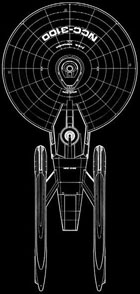
Menahga – dorsal orthographic |
Such a massive panning of Starfleet’s “great white hope” and the Federation’s new “champion of the border sectors” caused a massive uproar, both in the actual panning and, in an even greater furore, the fact that such major issues were not publically documented until an independent contractor was brought in. Accusations flew of cover-up and corruption, not to mention the possibility of criminal charges over wilful negligence and active abetting in premeditated manslaughter, from attempting to provide a poor-quality ship for front-line service in active trouble zones and hiding that it was poor quality, purely to ensure job security for those involved in its construction.

Menahga – fore orthographic |
This new and intense controversy over such an already controversial design threatened to scuttle the entire project, but the spectre of an unprepared Starfleet – or rather, a Starfleet comprised of mostly exploratory or at best dual-role cruisers, patrol escorts, and science vessels – attempting to hold the line against another conflict of the likes of the Federation-Mirak War swayed a great many Council votes.

Menahga – aft orthographic |
This spectre was countered by the success of the dreadnought recapitalisation (uprated Federation) and light dreadnought (Ascension) projects whose members were already on active duty, as well as the labelling of the Constitution class and her variants as “at best dual-role” being “at best” purely self-serving rhetoric and at the worst a grave insult to the crews of such valuable vessels whose myriad duties were well known.
In this manner, the dreadnought and battle cruiser appropriations survived by a small margin, though Starfleet suffered patrol combatant cutbacks across the board. The perimeter action and fleet carrier projects were shelved, and the improved dreadnought project was expected to end with the completion of the research stage. The battle cruiser project was permitted to continue as originally planned, with four proof of concept prototypes potentially leading to Low-Rate Initial Production (L.R.I.P.) construction contracts, as an in-between solution for more tactically-capable cruiser-class vessels for use in the Federation’s known trouble regions.
Then something happened in the wider galaxy to ensure the survival of Star Fleet’s more tactically-oriented classes for another round: The Klingon “Taal Tan” Offensive of mid-2283.
With Klingons pouring across the border and the apparent disappearance of the Organians from their self-appointed role of peacekeeper, the Federation Council flew into a panic. Many of the other tactically-oriented classes that were suffering a slow decline in support and appropriations – as a result of the earlier battle cruiser controversy and a sense of safety in the years following the Federation-Mirak War – suddenly received a windfall of appropriations, the battle cruiser being one of them. While deeply flawed, the role she was intended to fill was apparently still there, and still a hole in TacFleet’s Order of Battle.

Mitannic – port orthographic |
The Flight I prototype, 3103 Mitannic, was begun shortly after the Menahga was commissioned into experimental duty in 2279. As each flaw was revealed and documented through the first year of trials and evaluations, modifications were made to the Mitannic’s space frame, systems, and software while preserving the specific concept and general design. As with all engineering projects, though, to have a deliverable a design must be finalised. Many of Menahga’s more deep-seated flaws and the reasons for them were not documented until well after the majority of Mitannic’s construction was complete and mere ship outfitting remained.
During the Taal Tan Offensive the Mitannic was simply not combat ready as evaluations had barely begun, and while by the time the offensive was coming to a close Mitannic could have been rushed into service, concerns over just now “improved” she really was over her older sister kept her in experimental status rather than expose her to a potentially disastrous trial by fire.
Mitannic finally completed her own OT&E in late 2283. Compared to her older sister, the resulting vessel had her warp nacelles lowered and moved further back, her photon tubes incorporated into the MOSH in a tailored design solution, and the standard Class 1-B sensor suite installed. As a result, most of the major flaws of Menahga remained and any improvements were decidedly minor in nature.
With the Saess’Tan deconstruction in hand it was known that Mitannic would not fare well, and construction began on the Flight II prototype as soon as Mitannic was able to clear the dock. This time a more major re-design had been drawn up but still within the same design parameters; they were recognisably still sister ships.

S'Harien – port orthographic |
The Flight II prototype, 3107 S’Harien, was commissioned for OT&E duty in 2285 and after a further year of trials and testing it was apparent that this attempt had succeeded in correcting many of the Menahga’s operational flaws. Improvements and changes included:
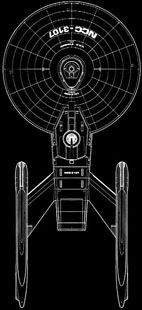
S'Harien – dorsal orthographic |
Unfortunately, point 1. above also led to the nacelles once again being elevated to be blocked by the saucer though, as this was done to reduce the warp nacelles’ vulnerability to incoming fire, the trade-off was considered acceptable.

S'Harien – fore orthographic |
While the S’Harien variant became the design the Menahga should have been six standard years earlier, with the introduction of the Athabasca-class “commando carrier” slightly earlier in 2286 the original “battle cruiser” concept suffered a mortal blow.
Began after the Saess’Tan controversy as a project by groups within Starfleet who specifically objected to the “purely combat-oriented” Menahga, the Athabasca was specifically designed to be a vessel that could fulfil the proposed role of the battle cruiser while being “more true to the ideals of Starfleet and the Federation”. Under the aegis – some might say “banner” – of Rear Admiral Dys Sy Sejkh, one of the principle opponents of the battle cruiser concept, not only would this group design and develop a ship which could out-perform the battle cruiser in both its primary roles, it would be multi-mission capable in the finest tradition of Starfleet.

Athabasca – port orthographic |
Rapidly designed and introduced into regular fleet service as a result of mating two proven hull designs – the Belknap-class strike cruiser and the Knox-class heavy frigate – into a superior-performing hybrid, the Athabasca’s expansive internal space allowed for the quartering of two companies of marines against the Menahga’s one. Athabasca’s three large shuttlebays with their clear lines of approach were vastly superior to S’Harien’s “one-and-a-half” access doors to a single, large, multi-level bay, and also allowed the individual tasking of bays to certain types of auxiliary craft, as well as damage control compartmentalisation in the event of her defences being breached.
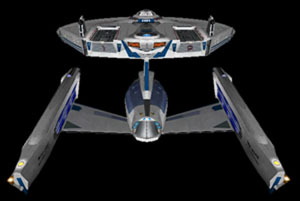
Athabasca – aft dorsal |
Athabasca also offered increased firepower with the inclusion of the Knox-class’ so-called “mega-phaser” mountings, which can be optionally installed with either warp-accelerated Type VII-M phasers for offensive punch, or Hydran-supplied defensive Type-V-G “Gatling” phasers for impressive defensive prowess. Coupled with offering the proven warp dynamic performance of the nimble Belknap-class, only mildly degraded with the extra mass of the Knox-based primary hull, the Athabasca came out on top of even the S’Harien variant in every category except hull protection. But when taken as a whole, the former proved harder to hit than the latter due to superior mobility and sub-impulse manoeuvrability.
While these trials and testing were specifically geared towards combat operations, it was also apparent from her completion as a standard Class One starship – i.e. outfitted with full scientific capabilities from sensors and computers to laboratories and embarked personnel – that the Athabasca was able to fulfil any of the duties routinely assigned to the escorts and cruisers of the Star Fleet. The Athabasca could be assigned regular patrol and Federation-level troubleshooting activities as would any Constitution-class vessel.
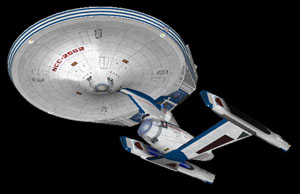
Athabasca – fore ventral port quarter |
Further to this, the Athabasca could also be re-tasked as an engineering support vessel. Indeed, in later years, these vessels were held in high regard and much in demand by the Starfleet Corps of Engineers due to the prodigious hanger space for Construction Bees, cargo space for building material storage and special system-related cargo, and her vast barracks facilities for workers. The Athabasca became the S.C.E.’s vessel of choice to deploy to regions with known hostiles or belligerents to contend with, either flying solo or as an escort for more traditional construction freighters.
In direct contrast, the Menahga variants were acknowledged from the start “as a limited-duration vessel” and a “single-purpose starship” that “personal comforts have been kept to a minimum” on and “her 305 personnel hopefully not manning her for any extended length of time”. Not only this, but having been built purely for battle and designed with “battle duration” as her motto, her intended deployment pattern was one of being kept docked “in retainer” at a starbase in extended readiness until an incident required her attention. Further to this, she had no diplomatic facilities and only a token scientific capability. There was no laboratory space, no embarked science personnel beyond a low-ranking science officer, and limited onboard scientific database.
Basically, S’Harien and her older sisters were strictly limited use as well as of limited duration.
This, then, was the real death knell for the Menahga variants: their original operational concept. While purporting to be an erstwhile battle cruiser, what its supporters had really been championing was a ship-to-ship-combat capable marine transport vessel; a commando cruiser which could protect itself while delivering its troops to their destination then engage in further ship-to-ship action. By attempting to mate these two disparate concepts into a single vessel they had doomed their “battle cruiser” from the start. With the Athabasca and her sisters showing how protected marine transport should be done, there was no longer a place in the Fleet for Menahga and her half-sisters. While these three test vessels continued to serve as active duty escorts, no class production was authorised.
However, the seeming inevitability of full-scale interstellar war with the Klingon Empire due to continued border clashes through the three years after Taal Tan, with the possibly of it also turning into a two-front war against the Romulans, secured one final attempt at a “true” battle cruiser class. With the success of the Athabasca-class in Menahga’s intended primary role, the battle cruiser project returned to the drawing board to design a new vessel without a marine contingent for their final prototype. Their new stated goal was to design “a heavy cruiser with the nimbleness of a destroyer” and after two years of redesign they believed they had it.
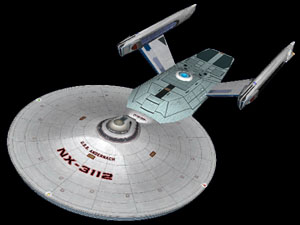
Andernach – fore dorsal port quarter |
The Flight III prototype U.S.S. Andernach NX-3112 was completed in 2291 and commissioned into extended trials and testing, due once again to being a brand new design. Taking onboard some lessons from their nemesis – the Athabasca-class development project – the Andernach redesign incorporated design elements from a couple of existing classes, suitably modified for the Andernach’s different role. Utilising a standard Class 1-B saucer, the Flight III prototype also specifically incorporated the Belknap class’ sturdier warp nacelle pylons and more responsive LN-68 mod 1 warp nacelles. These nacelles were optimised for faster acceleration, quicker response time, and increased warp-speed manoeuvrability, at the expense of vastly reduced time between projected component burnout and much higher fuel consumption rates. The pylons themselves were adapted to a more horizontal aspect to improve the vessel’s centre of gravity and increase sublight manoeuvrability, and totally discarded the Belknap class’ entire “detachable pylons” concept. In the Andernach these pylons were faired directly into the Warp Engineering section to reduce the length of plasma conduit necessary, further reducing the vessel’s vulnerability in combat.
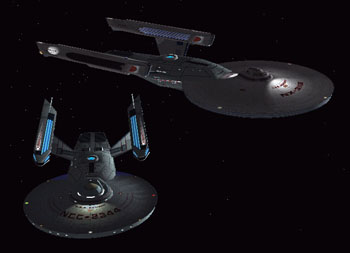
Andernach & the Okinawa-class Kyushu |
The Andernach’s most significant visual difference from her older half-sisters, however, came from utilising the design of secondary hull from the very successful Okinawa-class light multi-role frigate. While the Okinawa was a much smaller vessel, the general dimensional ratios of her secondary hull lent themselves very well to simple upsizing. The compact yet still voluminous hull generated by this 200% upsizing allowed the inclusion of an Excelsior-like shuttle-bay under the fantail at the lowest levels of the secondary hull along with the placement of the forward photon torpedo tubes, and the fantail was itself a perfect fit for the installation of the KR13-O warp reactor designed specifically for the battle cruiser project. The less complex hullform also allowed for the increase in deflector shield protection long touted as integral to the battle cruiser design but in a far less massive and slab-sided package. The shallower hull was also far more responsive to thruster-based manoeuvring, solving the “keel stabiliser” aspect of all the previous designs, and generally led to far greater and more responsive manoeuvrability at all speeds and to superior warp dynamics.
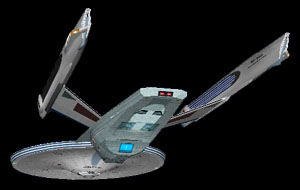
Andernach – aft ventral port quarter |
Another issue which was re-addressed was armament. While purporting to be a battle cruiser, the previous Menahga design variants actually had a reduced weapons suite from an uprated Constitution-class heavy cruiser. Mounting only the standard heavy cruiser torpedo arrangement of two forward tubes, a saucer phaser complement of six twinned-emitter phaser banks, plus five single-emitter phaser banks on the MOSH and WESH, the erstwhile battle cruiser actually had one fewer phaser banks than the uprated Constitution. On a cruiser design which was supposed to be optimised for combat operations this was deemed less than impressive, especially when the phaser arcs of three of the single emitters were blocked by the boxy, slab-sided MOSH on which they were emplaced or the warp nacelles, and that these single emitters delivered far less weight of fire to the target.
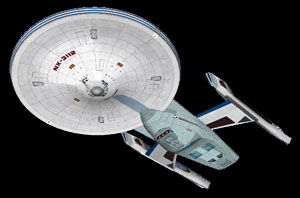
Andernach – fore ventral port quarter |
The Andernach re-design rectified this lack with a far superior weapons suite, prime among this being the three fore and two aft photon tubes. The Andernach re-design also emplaced twinned Type-VII emitters on the far aft fantail, the port and starboard lower flanks, and amidships on the dorsal surface of the secondary hull. Further, two single-emitter Type-V defensive phasers under the fantail give an impressive final tally of twenty-two phaser emitters in twelve banks, against the eighteen emitters in twelve banks of the uprated Constitution class, and the seventeen emitters in eleven banks of the S’Harien.
Also worth mentioning was the final lesson learned by the battle cruiser development project: that even though this was a vessel optimised for combat operations, she was still a cruiser of the Star Fleet. The use of a standard Class 1-B saucer also included far better crew accommodations than the Menahga variants and allowed her a standard cruiser patrol duration. Further, also included were limited scientific facilities on a par with an uprated Saladin-class escort. This allowed the Andernach to be tasked with any of the myriad duties expected of a standard cruiser so that this ship could actively patrol the danger areas and free less-protected vessels for duties in safer areas. Andernach was redesigned so as not to be a “keep it in the cupboard until we need it” vessel, and Starfleet took note.
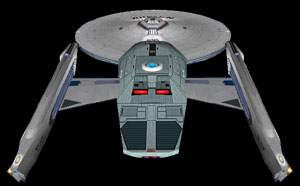
Andernach – aft dorsal |
In her trials she exceeded the expectations of those evaluating her, though much of that probably had more to do with so many previous disappointments than being something special herself. She acquitted herself well in all areas against her similarly re-drawn design requirements and, while not being as manoeuvrable as a destroyer, in the cruiser class she was more manoeuvrable than even the Belknaps. Finally satisfied that they had the battle cruiser they’d always wanted, Starfleet sought and was awarded appropriations to build a class of thirty vessels.
It was during the Andernach’s OT&E period that the Metar Crisis exploded, and much like Mitannic during the Taal Tan Offensive, Andernach was kept away from the killing fields as the trials had barely begun. In contrast, all three previous battle cruiser prototypes and several first batch Athabasca-class commando carriers were involved in the campaign. The Athabasca class proved their mettle during the latter stages of the Tabula Rasa Campaign by performing their assigned evacuation, reinforcement, construction, and combat missions flawlessly. Regrettably, against this far superior foe both Menahga and an Athabasca were lost in action, but not before proving at least some of the faith placed in both of them was justified.
By the time Andernach was cleared as ready for action, the campaign had already wound down but she was still deployed to the region to guard against a possible re-incursion by Metar forces, or in case in the aftermath the Klingons or Romulans decided to press their luck with – and claims against – the Federation.
The story of Starfleet’s first battle cruiser does not end there, however; the Mitannic design was used as the basis for the Maguellanes-class “modular” cruiser. Tracing its Federation roots back to the Absalom class of the early 21st-Century Royal Danish Navy, but more recently inspired by the success and versatility of the Romulan SparrowHawk class, the concept involved a standard Navy vessel with a replaceable hull section or “module”. This module can add additional tailored capabilities to the ship’s standard abilities, including but not limited to: command & control; cargo transport; marine operations; hospital; minelayer; fighter carrier; diplomatic cruiser.
Until the appearance of the Menahga’s secondary hull, Starfleet had never before developed a hull which would allow such a simple “swap out” replacement of hull sections. The excellent Miranda-class cruiser, while often referred to as a modular design, does instead have great versatility in internal configurations. Each ship can be built with an outwardly similar appearance, but internally could be configured as a border patrol heavy frigate, an exploratory light cruiser, a hospital ship, or more recently a light carrier, among many other variations. However, once built as such, any re-tasking is based solely on the ease of reconfiguring her as-built internal arrangement. For example, converting a hospital ship into a light carrier or vice-versa would not be feasible.
With the Menahga’s development elements of Starfleet finally saw in the vertically stacked, slab-sided secondary hull a design which, with only slight modifications, could accept some form of module within a suitably prepared “flex decks” volume. Enter the U.S.S. Maguellanes NX-7400.
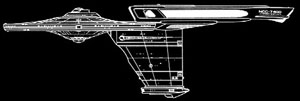
Maguellanes – port orthographic |
After the I.S.C. War of Pacification, Starfleet found itself short of cruisers with so many ships lost, rushed into the shipyards for repairs, or even more awaiting their turn for extensive repairs. During the war ships had been triaged, patched up just enough to go out and fight again. Systems that were not needed to fight the ship or keep her crew alive were simply ignored and once the Armistice had been signed, time was made to bring these badly damaged but still combat-capable ships in for full repairs. With this cruiser shortage, a joint group of Starfleet officers from TacFleet, the Engineering Corps, Logistics, the Auxiliary, and Colonial departments once again put forward their proposal to develop their “modular cruiser”. Having been turned down for this in the 2280s after the initial introduction of the Menahga, this group shelved their proposal and bided their time. Now, with the damage done to Starfleet by the I.S.C., they felt their time had come and re-proposed to an audience far more receptive to their ideas.
As with the battle cruiser project, they were authorised for a proof of concept prototype up to a maximum of four, the subsequent models of which would be authorised as required. However, by leveraging the terraquads of data generated by the battle cruiser project and taking their time to deliver a properly scoped vessel, the modular cruiser development project was able to take their design from computer simulation to the shipyard in a single year.
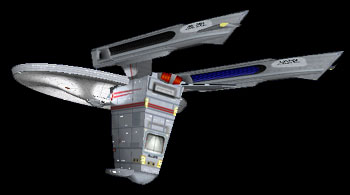
Maguellanes – aft port quarter |
Construction began on 7400 Maguellanes in 2299 and was completed in 2302, after which she was commissioned directly into her extended OT&E period. While similar to the battle cruiser prototypes in a broad sense, the internal differences were significant. The MOSH – once again a secondary hull – had its photon deck moved to the more vulnerable location at the bottom of the secondary hull, but since Maguellanes was not intended to be a combat vessel this relocation was deemed acceptable. The removal of the WESH and the reintegration of Warp Engineering into the upper levels of the secondary hull cleared the way for the mid-level decks to be used for the flex decks volume. Below Engineering, above the shuttlebay, and aft of the navigational deflector was a volume some 37m long, 26m deep, and 18m wide at minimum, taking up eight decks. Starfleet R&D determined that utilising roll-in equipment and pre-programmed robotic hull connections this volume could be used to house a module six decks deep while also allowing Jeffries Tube access all around its perimeter, between the module’s outer casing and the exterior hull plates of the ship. Also included were extensive lock-down struts which would firmly secure the module from all angles against the expected rigours and stresses of warp-speed flight, interstellar duty, and combat. Turbolift access to the module was not included in these connections; it was deemed impractical and a waste of space within the module itself. Access to the module from the ship was by twin airlock doors, port and starboard. All access within the module was by corridor and a central stairwell, back-to-back with a secondary lift for accessing the six decks only.
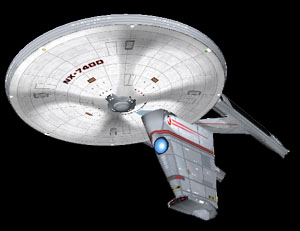
Maguellanes – fore port quarter |
Maguellanes’ OT&E period was a full year long, with special consideration given to Saess’Tan to complete exhaustive and transparent testing. The modular cruiser development project did not want a scandal similar to that of its indirect processor to scuttle them as well. As with the Menahga’s testing, the whole operational concept of their vessel was at stake. After almost six months of testing a number of recommendations came back, but all for relatively minor concerns which could be easily addressed. The vessel had come through her OT&E relatively unscathed and the Maguellanes team set about rectifying their design while the Starfleet Military Staff Committee pushed to secure authorisation for class production. Appropriations were given for a class build of nine more vessels built at shipyards around the Federation, with the option for a further twenty should the class prove to be as successful in service as her testing indicated she should be. In 2304 construction began on those vessels, all of which were completed in late 2307 and entered service in early 2308.
Currently, various Starfleet Command departments are going over the mission and maintenance logs of the first tour of these vessels to determine if appropriations for a second batch will be pursed with the Federation Council. By all accounts the vessels performed well enough in their assigned tasks, but the determination is being made as to whether these modular cruisers offer more value for resources than perhaps another batch of purpose-built Miranda-class cruisers. With this determination will be the final disposition of the Menahga design, and while not in its original battle cruiser role, perhaps those responsible for it will be rooting for it coming out on top again.
2275
Proposed “Battle Cruiser” concept authorised for four (4) pre-production hulls in the wake of the Federation-Mirak War.
2276
Prototype U.S.S. Menahga NX-3100 battle cruiser Flight 0 proof of concept vessel begins construction.
2279
Prototype U.S.S. Menahga NX-3100 battle cruiser Flight 0 proof of concept vessel enters extended builders trials, and operational testing with Star Fleet Division.
Prototype U.S.S. Mitannic NX-3103 battle cruiser Flight I proof of concept vessel begins construction, incorporating numerous improvements recommended from the ongoing trials & testing of NX-3100.
2280
A “Modular Cruiser” based on the Menahga hullform is proposed to the Starfleet Military Staff Committee, but is rejected.
Prototype U.S.S. Menahga NX-3100 battle cruiser Flight 0 proof of concept vessel enters OT&E with independent contractors Saess’Tan.
2281
Saess’Tan’s damning report almost causes cancellation of entire battle cruiser project and decommissioning of both units.
After intense debate, the battle cruiser project is allowed to continue. Prototype U.S.S. Mitannic NX-3103 battle cruiser Flight I proof of concept vessel is allowed to complete construction.
Parties within Starfleet opposed to the battle cruiser project secure appropriations to develop a vessel that can fulfil the proposed role while being “more true to the ideals of Starfleet and the Federation”.
2282
Prototype U.S.S. Mitannic NX-3103 battle cruiser Flight I proof of concept vessel enters trials & testing.
Prototype U.S.S. S’Harien NX-3107 battle cruiser Flight II proof of concept vessel begins construction, having been specifically re-designed to address Saess’Tan’s findings.
Battle Cruiser Opposition prototype U.S.S. Athabasca NCC-2560 begins construction.
2283
Taal Tan Offensive by the Klingon Empire against the U.F.P.
Prototype U.S.S. Mitannic NX-3103 battle cruiser Flight I proof of concept vessel completes trials & testing.
2285
Prototype U.S.S. S’Harien NX-3107 battle cruiser Flight II proof of concept vessel enters trials & testing.
2286
U.S.S. Athabasca NCC-2560 commissioned into OT&E duty. Due to being a variant design instead of a completely new one, her testing regime is shorter.
U.S.S. Athabasca NCC-2560 completes trials & testing and is commissioned into active duty, cleared for class production.
Prototype U.S.S. S’Harien NX-3107 battle cruiser Flight II proof of concept vessel completes trials & testing and is commissioned into active duty but not cleared for class production. With the success of the Athabasca in S’Harien’s intended primary role, the battle cruiser project returns to the drawing board to design a new vessel without a marine contingent for their final Flight III prototype.
Prototype U.S.S. Menahga NX-3100 battle cruiser Flight 0 proof of concept vessel is commissioned into active duty.
Prototype U.S.S. Mitannic NX-3103 battle cruiser Flight I proof of concept vessel is commissioned into active duty.
2288
Prototype U.S.S. Andernach NX-3112 battle cruiser Flight III proof of concept vessel begins construction.
2290
First production-run Athabasca-class “commando carriers” enter service
2291
Prototype U.S.S. Andernach NX-3112 battle cruiser Flight III proof of concept vessel enters extended trials & testing.
The three battle cruiser prototypes and several first-batch Athabasca-class commando carriers see action during the Metar Crisis.
2292
Prototype U.S.S. Andernach NX-3112 battle cruiser Flight III proof of concept vessel completes trials & testing and is commissioned into active duty, cleared for class production due to the state of general war in the locals pace region and the threat of impending war with the Klingon Empire.
2293
Praxis & Khitomer: War and Peace for the Klingon Empire.
2295
First production-run Andernach-class battle cruisers enter service, see immediate action during the I.S.C. War of Pacification.
2296
United Federation of Planets officially declares war on the InterStellar Concordium for acts of war against the U.F.P. and their allies. The Klingon Empire also declares war on the I.S.C. and begins joint operations with Starfleet.
2298
The I.S.C. overextend themselves and are defeated by the combined Local Space powers. The I.S.C. High Command sign an Armistice on board the U.S.S. Molnijr, a Ulysses-class heavy dreadnought.
Rebuilding of fleets and infrastructure begins for all Local Space powers.
The Modular Cruiser is once again proposed to the Starfleet Military Staff Committee, and this time is accepted for development. Appropriations are obtained for a single prototype, with options for a further three (3) to be authorised as required.
2299
Prototype U.S.S. Maguellanes NX-7400 modular cruiser Flight 0 proof of concept vessel begins construction.
2302
Prototype U.S.S. Maguellanes NX-7400 modular cruiser Flight 0 proof of concept vessel completes construction and is commissioned into extended OT&E with Starfleet Division and then Saess’Tan.
2303
Prototype U.S.S. Maguellanes NX-7400 modular cruiser Flight 0 proof of concept vessel completes OT&E successfully and is cleared for class production.
2308
First batch of nine (9) additional Maguellanes-class modular cruisers enter active duty.
2312
Maguellanes-class performance over first tour under review for determination of second batch production.
This article was also inspired by yet another intense discussion with Adrian Jones of Star Trek: The Interim Years / U.S.S. Sheffield NCC-1976. He has a nasty habit of digging up ugly old ships and bringing them into his universe. Now, having the original Starship Design fan publication with the Menahga article, I simply had to weigh in and give an admittedly biased counterpoint to Ady's enthusiasm for "Starfleet's battle cruiser". I simply don't like the design from a philosophical, design, conceptual, operational, and by no means least an aesthetic standpoint.
However, I do like the Athabasca and the Maguellanes, and while perhaps not in the roles intended by their creators this is my corner of the Trek universe and the Star Fleet is not a primarily military organisation here.
Hence, my little re-telling of history and my weaving together of all the disparate elements of my universe's events.
This article uses vessels, concepts, quotes, and even a person from Starship Design, Starfleet Prototype, Starfleet Dynamics, Ships of the Star Fleet Vols. 1 & 2, and ship classes and 3D models created by the awesome SFC modding community – of which I am a talented dabbler – for the Starfleet Command series of PC games by Taldren/Interplay. All rights are reserved by the creators of their respective intellectual properties.
Menahga
© 1983 Tactical Battlecruiser Development.
Belknap class
© 1984 Starship Design.
Knox class
© 1984 Starship Design.
Mitannic
© 1987 Federation Starship Recognition Chart.
Daran class
© 1991 Ships of the Star Fleet - Volume One.
Darter class
© 1991 Ships of the Star Fleet - Volume One.
Andernach name and registry
© 1991 Ships of the Star Fleet - Volume One.
(The kitbashed ship model is by me, Scottish Andy.)
Akyazi class
© 1992 Ships of the Star Fleet - Akyazi-Class Perimeter Action Ships - Volume Two.
S'Harien
© 1992 Starfleet Prototype.
Athabasca (Athabaska) class
© 1992 Starfleet Prototype.
Maguellanes class
© 1993 Jackill's Star Fleet Reference Manual - Ships of the Fleet Volume II.